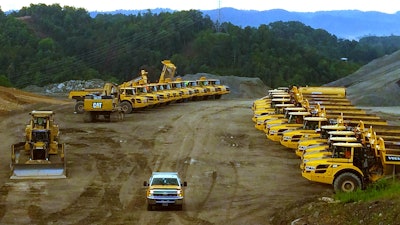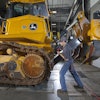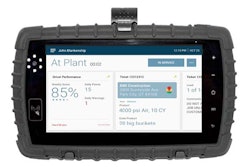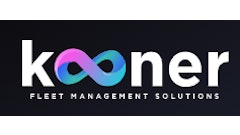
By Gregg Wartgow, Contributing Editor
Equipment managers are tasked with optimizing fleets of equipment – optimizing in terms of utilization, productivity, safety and cost efficiency. Whether working in the public or private sectors, this is the calling of an equipment manager.
“There is sometimes a presumption that because there is a profit motive in a commercial or corporate enterprise, there must be better fleet management practices in the private sector,” says Paul Lauria, president of Mercury Associates, a fleet consulting company. “We have not found that to be the case at all. The biggest reason why is that private companies are typically subjected to much less scrutiny than public agencies because of sunshine laws, inspector generals, internal auditors and elected officials.”
That heightened element of scrutiny in the public sector can impact fleets in another way: change implementation.
Kevin Schlangen, CEM and 2018  CEM Kevin Schlangen (far left) and his team at Dakota County Fleet Management in Minnesota.
CEM Kevin Schlangen (far left) and his team at Dakota County Fleet Management in Minnesota.
Schlangen thinks back to when he made the switch to the public sector. “The major difference I felt right away, which is still true today, is the speed at which change can take place,” Schlangen says. “In the private sector, you can come up with a new process or product you want to implement and run with it. In the public sector, there are more levels to go through for approval before starting that change.”
To successfully navigate those approval levels, public sector fleet managers need two tools in their toolbox: data and salesmanship. Private sector fleet managers need those same tools, but perhaps to a lesser degree. It all depends on the company’s level of sophistication.
Get your data in order
In today’s environment, data-based decision-making is a hallmark of any great equipment manager. In many instances, it is expected by senior management – especially in the public sector.
“Today’s fleet management professionals are expected to employ data-driven fleet management practices,” Lauria says. “More company owners are coming to understand this. It’s also fair to say that such an expectation is even more germane to a public sector fleet.”
Lauria says the private sector can cover a broad spectrum of construction companies, from small family-run businesses to major international firms. Some companies have the data component really dialed in. Others rely more on traditional “gut instinct”. It largely depends on the level of accountability and transparency the company assigns its fleet management department.
[SPONSORED] Increase profitability and efficiency with your fleet now with a free fleet management system demo >>
“When working with private sector clients, we are sometimes taken aback by the weaknesses we observe with respect to their fleet management practices,” Lauria says. “For instance, one fairly large company had around 1,000 fleet assets, but was unable to provide us with a complete inventory of all of those assets. That is unheard of in a government fleet. If we were to encounter some small county in a remote part of the country, it would still be highly unusual.”
Beyond basic inventory and accounting practices, equipment data is the critical component in a public entity. Schlangen’s team calculates its cost per hour and mile for every piece of equipment it has, factoring in all operating costs right down to insurance. “We need to have numbers to be able to prove that it makes more sense to own than rent, for example, or to reimburse government employees for mileage vs. providing them with a work vehicle.”
To help gather some of that data,  Public fleets can be very diverse. Pictured is a police patrol vehicle in for service at Dakota County Fleet Management in Minnesota.
Public fleets can be very diverse. Pictured is a police patrol vehicle in for service at Dakota County Fleet Management in Minnesota.
Top-level private sector fleet managers are also leveraging telematics. Case in point: Aaron Mayer, another 2018 Fleet Masters award winner. Mayer is equipment manager for Ryan Incorporated Central, a site-work contractor based in Janesville, Wis. They key to telematics data, he says, is to make it readily available and actionable. If an equipment manager is spending 80% of his or her time gathering data but only 20% analyzing it, that probably isn’t time well-spent.
It has taken a few years, but Mayer and his team now have processes and technologies in place to make good use of their telematics data. When it comes to optimizing his fleet, however, Mayer says there is no substitute for good cost accounting.
Take a 25-ton excavator, for instance. A fleet could be shopping between several different manufacturers. The easiest thing to do is simply look at the sticker price. But an equipment manager has to consider the overall life of the asset, which in this case might be three to seven years.
“Ownership cost is only a quarter to a third of the overall operating cost,” Mayer says. “The next biggest cost is typically fuel, followed by other operating costs such as preventive maintenance and repairs. If an equipment manager doesn’t have a good handle on this total cost of owning and operating, it is difficult to make good asset acquisition decisions. Some of my peers on the public-sector side have talked to me about their bidding and acquisition process. To a large degree, it is a very structured, black-and-white process of requesting bids, which makes it harder to differentiate machines and understand the total cost of owning and operating.”
Not all private-sector fleet managers do as good a job as Mayer at avoiding the over-fixation on purchase price. Again, it has a lot to do with the company and its level of sophistication.
Lauria says some private sector construction companies are especially concerned about preserving cash. Thus, they buy a lot of used vehicles and equipment without giving much thought to total cost of ownership. “That is not the type of behavior you’ll typically encounter in a public agency,” Lauria adds.
For instance, Schlangen and his team have developed a process for prioritizing capital expenditures across the numerous departments for which they provide fleet services. They’ve developed formulas for evaluating when to right-size fleets, and when to replace, rent or eliminate given machines. This helps the county space out capital expenditures from year to year, which helps to manage within the confines of a tight budget.
To further adapt to public sector budget restraints, Schlangen says his team has eliminated a fair amount of underutilized equipment. “Sometimes you’re better off to go out and rent, which helps free up resources,” he explains. “An equipment manager has to explain the ramifications of certain decisions, such as putting off a machine replacement. You need numbers to do that. When you can explain the ramifications in numbers, people can understand.”
Put on your salesperson hat
Sound numbers certainly help an equipment manager make his or her case. So does a little bit of salesmanship.
“A fleet manager working for even a small county is part of a multi-million-dollar enterprise,” Lauria says. “Most smaller companies do not have a budget committee; they might have a CFO who is giving the final say on capital expenditures. In the public sector, there are more layers and more players in the development of budgets and approving of capital expenditures.”
Mayer says that in his private sector role,  CEM Aaron Mayer says ownership cost is as little as a quarter of the overall life cost of a machine. It’s important for fleet managers to have a firm grasp on what it costs to operate and maintain each piece of equipment in the fleet.Ryan Incorporated Central
CEM Aaron Mayer says ownership cost is as little as a quarter of the overall life cost of a machine. It’s important for fleet managers to have a firm grasp on what it costs to operate and maintain each piece of equipment in the fleet.Ryan Incorporated Central
It helps that Mayer and his team are constantly gathering and analyzing data. “We’re studying everything, including things like fuel burn,” Mayer points out. “I can go to the rest of the management committee and make the case for why we need a new excavator, and then present data on which excavator we think will be the best.”
To garner that kind of confidence from decision-makers, data remains an equipment manager’s best friend. In the public sector, Schlangen says data also helps prove an equipment manager’s worth.
“I have to present an operating budget and capital expenditure budget,” Schlangen says. “Part of that is selling the value of the services we’re providing. When that time comes to stand in front of the different department leaders and elected officials, we need to be capable of talking about KPIs (key performance indicators) and how we’re providing value. Every law enforcement deputy and truck driver is a customer of ours. Our value must be better than going across the street to another fleet services provider in the private sector.”
To help enhance its value, Schlangen’s fleet services department maintains ASE certification. This helps ensure a certain level of expertise at the technician level. Then, Schlangen says he must prove his value as a trustworthy partner.
“If I’m going to ask for $2 million in next year’s budget to add or replace equipment, I need to be able to explain why,” Schlangen says. “In the private sector, it’s easier to say, ‘We have a big job coming up and need a new excavator.’ In the public sector, you need to show the value of an up-to-date and well-maintained fleet – along with how your team helps provide it.”
Widen your knowledge base
One major different between public and private sector fleets can be asset diversity. Lauria says that even a larger city could operate everything from police patrol cars, fire trucks and ambulances to excavators, cranes and dump trucks.
“A large government jurisdiction often has around 150 types of assets,” Lauria points out. “There is much more homogeneity in a private fleet, which also makes it more possible to explore the outsourcing of some maintenance services. Some government employees are also unionized in different parts of the country, which also puts some constraints on outsourcing in the public sector.”
Schlangen is in charge of a diverse fleet of  Fleet management teams in the public sector must show that the value they provide is better than going across the street to another fleet services provider in the private sector.
Fleet management teams in the public sector must show that the value they provide is better than going across the street to another fleet services provider in the private sector.
“In the public sector, you can feel like you own one of everything ever made,” Schlangen relates. “You might be in the street sweeping business, snow removal, grounds maintenance and law enforcement. You’re transporting prisoners and doing things with public health. It’s a huge amount of different pieces of equipment.”
How does a fleet manager keep up? Schlangen says he’s fortunate that his employer, Dakota County, believes in education and networking, allowing him and his staff to attend things like conferences. “You can make so many great connections with peers who have some expertise in different areas,” Schlangen says. “You can also connect with vendors to keep up with what’s new in the industry.”
Along those same lines, Schlangen says an equipment manager must constantly read about the different industries he or she is helping to support. “I can’t even tell you the number of trade magazines I get every month,” he relates.
Feedback from users is essential – especially in the public sector where fleets are so diverse. That is why Schlangen has worked to establish a user advisory group where vehicle and equipment operators from different departments offer insights and feedback.
Whether working in the public or private sector, an equipment manager has one job to do: assemble and maintain the most productive, safe and cost-effective fleet possible. While some differences exist in how an equipment manager gets to that ultimate end game, there are just as many similarities. Data, salesmanship, technical expertise and passion are tools any equipment manager needs.


















